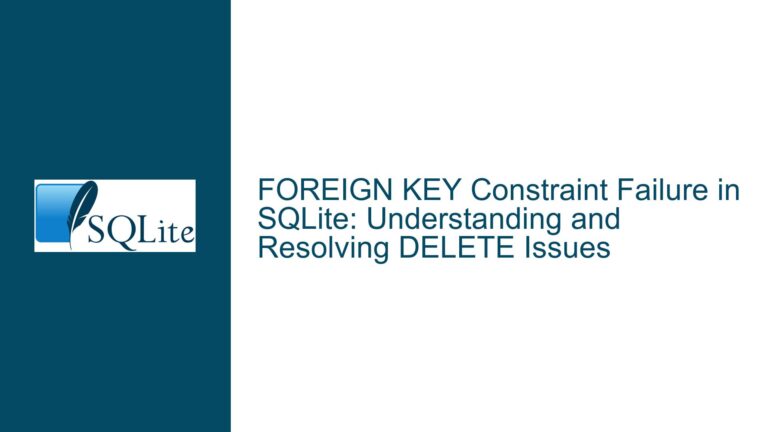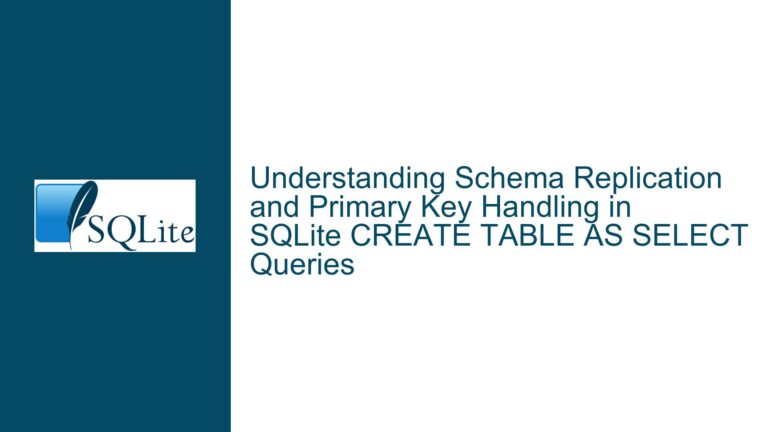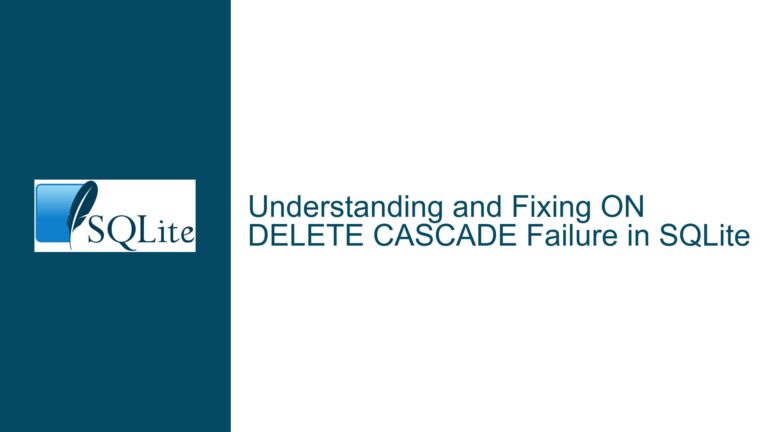Foreign Key Constraints Fail Across Attached SQLite Databases
Cross-Database Foreign Key Enforcement Limitations in SQLite
Schema Attachment Behavior and Foreign Key Scope Restrictions
Core Problem Analysis
The central challenge revolves around attempting to enforce foreign key relationships between tables residing in separate SQLite database files attached via ATTACH DATABASE. When creating table logs.logUsers with a foreign key reference to main.users(id), SQLite throws "no such table: logs.users" during insertion attempts. This occurs despite both databases being attached and their tables being accessible via qualified schema names (e.g., main.users).
SQLite’s foreign key implementation exhibits three critical constraints in this scenario:
- Schema Qualification Syntax Limitation: The
REFERENCESclause in foreign key declarations cannot explicitly specify a database/schema name. AttemptingREFERENCES main.users(id)generates a syntax error because the parser expects only a table name followingREFERENCES - Scope Isolation: Foreign key constraints are enforced strictly within the schema/database where the child table resides. When creating
logs.logUsers, SQLite interprets unqualifiedREFERENCES users(id)as pointing tologs.users(the same schema as the child table), notmain.users - Attachment Transience: Attached databases exist only for the duration of the connection. Even if cross-database references were permitted, detachment or connection closure would orphan the constraints
This behavior contrasts with enterprise RDBMS like Oracle which support fully qualified cross-schema references. SQLite’s architecture treats attached databases as separate entities with limited interoperability beyond basic data access via schema-qualified table names.
Underlying Architectural Constraints
Four fundamental SQLite design principles contribute to this behavior:
- Database File Autonomy: Each
.sqlitefile operates as a complete, self-contained database unit. Foreign key enforcement mechanisms are implemented at the b-tree level within individual database files - Transaction Scope Limitations: SQLite transactions cannot atomically span multiple database files. Cross-database foreign keys would require multi-file transaction coordination unsupported by the current architecture
- Schema Metadata Localization: The
sqlite_schematable (containing foreign key metadata) exists per-database file. There’s no global schema registry coordinating constraints across attached databases - Connection-Local Attachments: Attached databases are connection-specific and temporary. Permanent cross-database constraints would require persistent attachment configuration storage, which SQLite deliberately avoids
These constraints make cross-database foreign key enforcement theoretically impossible under SQLite’s current design without significant architectural changes.
Resolution Pathways and Workarounds
Schema Consolidation Strategy
The most straightforward solution involves merging related tables into a single database file:
- Single-File Normalization:
CREATE TABLE users (
id INTEGER PRIMARY KEY,
name VARCHAR(50) NOT NULL UNIQUE
);
CREATE TABLE logUsers (
id INTEGER PRIMARY KEY,
parentId INTEGER NOT NULL REFERENCES users(id) ON DELETE CASCADE,
message TEXT NOT NULL
);
- Logical Separation via Schema Prefixes (within single file):
CREATE TABLE main_users (...);
CREATE TABLE logs_logUsers (... REFERENCES main_users(id));
- Views for Namespace Simulation:
CREATE VIEW logs.logUsers AS SELECT * FROM logUsers;
CREATE TRIGGER logs.logUsers_insert INSTEAD OF INSERT ON logs.logUsers
BEGIN
INSERT INTO main.logUsers(parentId, message) VALUES (NEW.parentId, NEW.message);
END;
Trigger-Based Referential Integrity
Implement cross-database constraints through manually created triggers:
-- In main database connection after ATTACHing logs.sqlite
CREATE TEMP TRIGGER logs_logUsers_parentId_fk
BEFORE INSERT ON logs.logUsers
BEGIN
SELECT RAISE(ABORT, 'Invalid parentId')
WHERE NOT EXISTS (
SELECT 1 FROM main.users WHERE id = NEW.parentId
);
END;
CREATE TEMP TRIGGER logs_logUsers_parentId_cascade
AFTER DELETE ON main.users
BEGIN
DELETE FROM logs.logUsers WHERE parentId = OLD.id;
END;
Key Trigger Considerations:
- Use
TEMPtriggers to avoid schema modifications in attached databases - Attach triggers programmatically on database connection
- Implement error handling for missing attached databases
- Include transaction blocks for multi-database operations
Application-Level Enforcement
When schema modifications are impractical, enforce constraints in application code:
async function insertLogUser(parentId, message) {
const tx = await db.beginTransaction();
try {
const userExists = await db.get(
'SELECT 1 FROM main.users WHERE id = ?',
[parentId]
);
if (!userExists) throw new Error('Invalid parentId');
await db.run(
'INSERT INTO logs.logUsers(parentId, message) VALUES (?,?)',
[parentId, message]
);
await tx.commit();
} catch (e) {
await tx.rollback();
throw e;
}
}
Optimization Techniques:
- Cache valid foreign keys in memory when possible
- Use batch operations with pre-checking
- Implement retry logic for concurrent modifications
Hybrid Approach with Shadow Tables
Create synchronization infrastructure between databases:
- Main Database Schema:
CREATE TABLE users (
id INTEGER PRIMARY KEY,
name VARCHAR(50) NOT NULL UNIQUE
);
CREATE TABLE fk_sync (
table_name TEXT PRIMARY KEY,
last_verified INTEGER DEFAULT 0
);
- Logs Database Schema:
CREATE TABLE logUsers (
id INTEGER PRIMARY KEY,
parentId INTEGER NOT NULL,
message TEXT NOT NULL
);
CREATE INDEX idx_logUsers_parentId ON logUsers(parentId);
- Synchronization Procedure:
async function verifyForeignKeys() {
const tables = await db.all('SELECT table_name FROM logs.fk_sync');
for (const {table_name} of tables) {
const {last_verified} = await db.get(
'SELECT last_verified FROM logs.fk_sync WHERE table_name = ?',
[table_name]
);
const invalidRows = await db.all(
`SELECT l.parentId
FROM logs.logUsers l
LEFT JOIN main.users u ON l.parentId = u.id
WHERE u.id IS NULL
AND l.rowid > ?`,
[last_verified]
);
if (invalidRows.length > 0) {
throw new Error(`Orphaned rows found in ${table_name}`);
}
await db.run(
'UPDATE logs.fk_sync SET last_verified = ? WHERE table_name = ?',
[Date.now(), table_name]
);
}
}
Performance Considerations:
- Schedule verification during low-usage periods
- Use incremental verification with rowid tracking
- Maintain coverage statistics to optimize check frequency
Connection Management Pattern
Implement rigorous attachment lifecycle management:
class MultiDatabaseConnection {
constructor(mainFile, attachments = {}) {
this.db = new sqlite3.Database(mainFile);
this.attachments = new Map();
for (const [schema, file] of Object.entries(attachments)) {
this.attach(schema, file);
}
}
attach(schema, file) {
return new Promise((resolve, reject) => {
this.db.run(
'ATTACH DATABASE ? AS ?',
[file, schema],
function(err) {
if (err) return reject(err);
this.attachments.set(schema, file);
resolve();
}
);
});
}
detach(schema) {
return new Promise((resolve, reject) => {
this.db.run(
'DETACH DATABASE ?',
[schema],
function(err) {
if (err) return reject(err);
this.attachments.delete(schema);
resolve();
}
);
});
}
ensureForeignKeys() {
// Implement trigger creation/validation
}
}
Lifecycle Considerations:
- Re-attach databases on connection reuse
- Verify schema consistency on attachment
- Maintain attachment manifest in application state
Architectural Alternatives and Future Considerations
While SQLite core may never support cross-database foreign keys due to architectural constraints, these patterns provide robust alternatives:
Composite Database Middleware:
- Develop a virtualization layer presenting multiple DB files as single schema
- Route queries/updates to appropriate files
- Maintain cross-file constraint metadata
Extension-Based Solutions:
// Hypothetical SQLite extension snippet static void crossdb_fk_check( sqlite3_context *context, int argc, sqlite3_value **argv ) { const char *child_db = (const char*)sqlite3_value_text(argv[0]); const char *parent_db = (const char*)sqlite3_value_text(argv[1]); // Implement cross-database validation logic } sqlite3_create_function( db, "crossdb_fk_verify", 2, SQLITE_UTF8, 0, crossdb_fk_check, 0, 0 );Usage:
CREATE TABLE logs.logUsers ( ..., FOREIGN KEY (parentId) CROSSDB_REFERENCES main.users(id) );Versioned Schema Packages:
- Bundle related tables in versioned schemas
- Use migration tools for coordinated updates
- Deploy as single SQLite file per schema version
These approaches require significant development effort but demonstrate viable pathways for organizations needing cross-database referential integrity while maintaining SQLite’s benefits.






